The Classic 4 day Inca Trek covers about 50Km and ends at Machu Picchu, the largest and best preserved ruin of an Inca settlement. For Centuries it was buried deep in the high Jungle (at 2,472m/8,000ft) until it was rediscovered by an academic from Yale named Hiram Bingham in 1911. He took 60 boxes of Inca artefacts back to the States which the Peruvians have been trying to recover ever since.
Off we set on our 50km walk. It does not sound very taxing until you take into account the altitude (up to 4,215m/13,700ft), the difficulty of the terrain (I mean steep!) and the fact that we covered it in only 3 days. It is also a bit hard-arsed in that the nights are extremely cold (you go to sleep fully dressed) and the showers are so cold everyone goes smelly. From a female point of view (i.e. not mine) the loos are a little trying. They are only available at lunch and overnight stops and are a mixture of squatters and normal toilets that do not have seats (so, in reality, they are either high or low squatters). They always smell bad. No issues then from a bloke’s point of view.
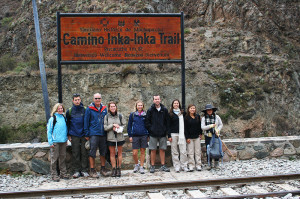 Our ‘party’ consisted of 26 people. 9 paying customers (2 plucky old Brits, 2 lost Kiwis, 2 serious Germans, 2 happy-go-lucky Aussie girls and a Brazilian Lady with limited English), 2 guides and 15 porters (including one that was euphemistically called a Chef). While the local guides spoke decent English, the porters didn’t. Neither did they speak Spanish but rather Quechua, the local language, and the tongue of the Incas. Most of our communication with them was done with exaggerated arm and eyebrow movement or, as a last resort because it was gutless, through the guides.
Our ‘party’ consisted of 26 people. 9 paying customers (2 plucky old Brits, 2 lost Kiwis, 2 serious Germans, 2 happy-go-lucky Aussie girls and a Brazilian Lady with limited English), 2 guides and 15 porters (including one that was euphemistically called a Chef). While the local guides spoke decent English, the porters didn’t. Neither did they speak Spanish but rather Quechua, the local language, and the tongue of the Incas. Most of our communication with them was done with exaggerated arm and eyebrow movement or, as a last resort because it was gutless, through the guides.
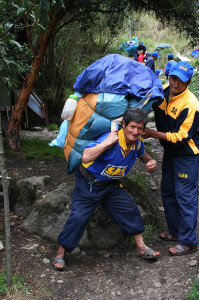 We never walked together as a party and so we missed the opportunity to block up the entire mountain. The guides and customers would set off first leaving the porters to break camp after either breakfast or lunch. The porters would then overtake us after a couple of hours, running past carrying huge loads and sweating profusely. By the time we reached the lunch or evening stop the camp would be set up. It is impossible not to admire the effort they put in to their task which they do with a smile and good nature always. They are all small guys who are half my size and weight but carry 25 kg on their backs and all of them have inappropriate footwear (flip flops/ broken shoes/sandals) but they scamper about the mountain like Ibex. The oldest of them, whose name I cannot remember, was 60 years old but still enjoyed the mountains and carried as much as any of the others.
We never walked together as a party and so we missed the opportunity to block up the entire mountain. The guides and customers would set off first leaving the porters to break camp after either breakfast or lunch. The porters would then overtake us after a couple of hours, running past carrying huge loads and sweating profusely. By the time we reached the lunch or evening stop the camp would be set up. It is impossible not to admire the effort they put in to their task which they do with a smile and good nature always. They are all small guys who are half my size and weight but carry 25 kg on their backs and all of them have inappropriate footwear (flip flops/ broken shoes/sandals) but they scamper about the mountain like Ibex. The oldest of them, whose name I cannot remember, was 60 years old but still enjoyed the mountains and carried as much as any of the others.
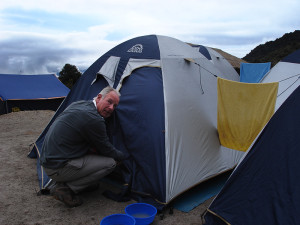 We would usually be woken at 5.00am, just as it was getting light, with a cup of mate tea made from coca leaf. It is not our tea of choice but it is not possible to get Earl Grey around here. I only managed to drink it on the first day as my tent mate threw it all over my sleeping bag and mattress on the second morning which certainly managed to get me out of bed quickly. In fact coca seems to be the local cure-all for every ailment. It is claimed that it cures headaches, stomach ailments, altitude sickness, ‘marital problems’ and anything else that we may be suffering. However, I suspect that not to be true as I still have athlete’s foot and dandruff and my golf swing still tends to be a little in-to-out. The porters chew the leaf all day long, taking great handfuls of the stuff and ruminating on it for hours. They must be in perfect health!
We would usually be woken at 5.00am, just as it was getting light, with a cup of mate tea made from coca leaf. It is not our tea of choice but it is not possible to get Earl Grey around here. I only managed to drink it on the first day as my tent mate threw it all over my sleeping bag and mattress on the second morning which certainly managed to get me out of bed quickly. In fact coca seems to be the local cure-all for every ailment. It is claimed that it cures headaches, stomach ailments, altitude sickness, ‘marital problems’ and anything else that we may be suffering. However, I suspect that not to be true as I still have athlete’s foot and dandruff and my golf swing still tends to be a little in-to-out. The porters chew the leaf all day long, taking great handfuls of the stuff and ruminating on it for hours. They must be in perfect health!
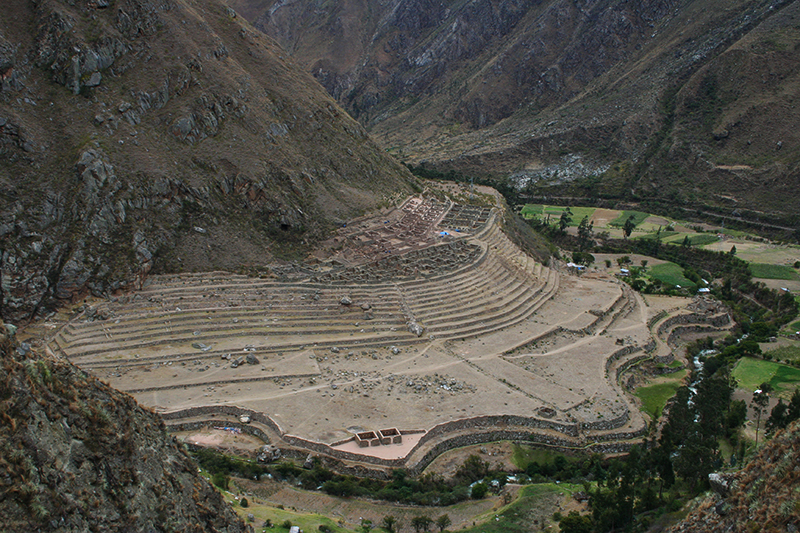 The first day’s walk was pretty easy. A gentle incline that led us to our lunch stop at an Inca settlement called Q’entimarka (aka Patallaqta). Aldo, our main guide, claimed that it was constructed in the shape of the foot of a panther but you needed a pretty good imagination to suppose that was the purpose as it seemed to me to be a standard defensive rampart. We were to learn that everything Inca, according to the guides, was built in the shape of some animal, object or deity that was obvious only to those chewing sufficient coca. Anyway, it made a good story along with other ‘facts’ such as there are over 400 different types of potato in Peru (this includes coca) and 540 different types of bean (also including coca).
The first day’s walk was pretty easy. A gentle incline that led us to our lunch stop at an Inca settlement called Q’entimarka (aka Patallaqta). Aldo, our main guide, claimed that it was constructed in the shape of the foot of a panther but you needed a pretty good imagination to suppose that was the purpose as it seemed to me to be a standard defensive rampart. We were to learn that everything Inca, according to the guides, was built in the shape of some animal, object or deity that was obvious only to those chewing sufficient coca. Anyway, it made a good story along with other ‘facts’ such as there are over 400 different types of potato in Peru (this includes coca) and 540 different types of bean (also including coca).
After lunch they made us walk an extra hour, past our official campsite and on to another that was, apparently, more pleasant. We stopped at 5.00pm and sorted out our stuff before Happy Hour at 6.30 when we all met in the dining tent to have tea and pop corn before dinner. There was never a shortage of food for us to eat and, on the whole, it was good. But there were no gin wallahs around and nothing more alcoholic than water but oddly enough we did not miss it; I suppose it must have been the different environment. Occasionally, we walked past places, indicated by the flying of a red plastic bag, that sold a beer, ‘Chicha de jora’, home made from corn that had a brownish tinge to it and looked as if it had been manufactured from dirty washing up water. It tasted foul and was enough to put you off alcohol forever but the guides and porters treated it like nectar and drank gallons of it.
That night we discovered exactly how cold it can be camping at altitude. We were ‘only’ at 3,300m (10,725ft) but we crawled into our sleeping bags with all our clothes and shivered. When you wake up needing to go to the loo, you lie there wondering whether you can avoid going so as not to have to extract yourself from your bag, find your boots, unzip the tent and stumble to the toilets without waking the entire camp. After lying around for half an hour you realize it is impossible to avoid going if you want to get back to sleep and the next ten minutes are spent trying to locate the position you left the torch and the toilet paper. At least when you return, you can derive some satisfaction from the sound of other tents being unzipped by fellow campers with the same problem. And it doesn’t do to have too much imagination; one of the Aussie girls was convinced there was some large animal prowling outside her tent and dare not venture outside for fear of being eaten.
The second day is the hardest. We had to climb over the highest pass on the trail and descend into the high jungle on the other side. After a lunch break, we had to climb over another pass almost as high as the first before descending into cloud and mosquitoes.
The first pass is known as Dead Woman’s Pass because, from a distance, it looks like a woman lying on her back who has had breast augmentation. For once no imagination was required to see why it was so called and it would be impossible to get lost in the area whilst trying to pass it. The route up was lined with stones, all of which had been deliberately (or so it seemed) laid unevenly with some very large steps upward. After 30 minutes I wondered why they had to use such large stones for steps; why could they not have used smaller ones that would be a lot easier to climb? And with all that mountain, why did they have to make it so steep? And, while they were about it, why couldn’t they have lowered the pass a bit? Why had I allowed Debbie to bring me on another trek?
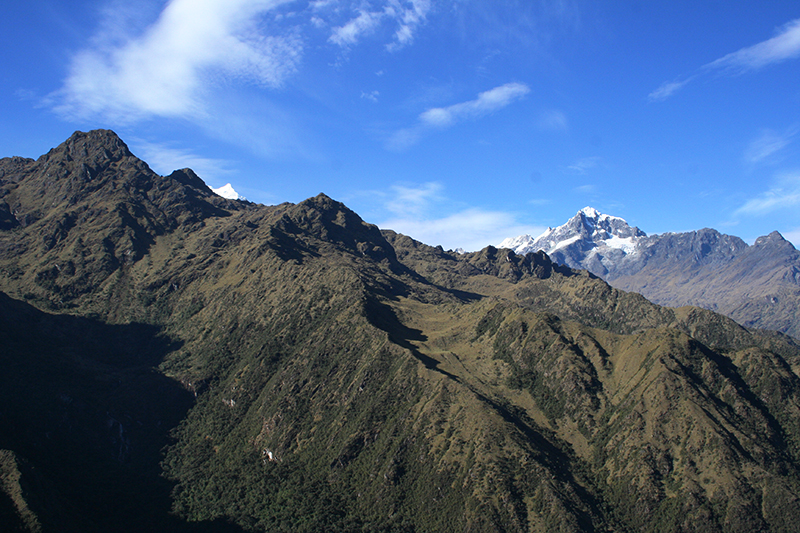 When we got to the top at 4,215m (13,700ft) we were knackered and very sweaty. But, I was told, it was worth it for the magnificent views. Behind us were the crystal clear peaks of Llullchayoq and Wayllabamba and in front the tops of the inner range of the Andes stretched out forever as they struggled to stay above the cloud of the high jungle. We had plenty of time to admire the views because we had got to the top well ahead off all but one of our group which also gave us some smug satisfaction that the two oldest and most decrepit could still show the youngsters a clean pair of heels.
When we got to the top at 4,215m (13,700ft) we were knackered and very sweaty. But, I was told, it was worth it for the magnificent views. Behind us were the crystal clear peaks of Llullchayoq and Wayllabamba and in front the tops of the inner range of the Andes stretched out forever as they struggled to stay above the cloud of the high jungle. We had plenty of time to admire the views because we had got to the top well ahead off all but one of our group which also gave us some smug satisfaction that the two oldest and most decrepit could still show the youngsters a clean pair of heels.
The climb after lunch was probably harder as the body had relaxed and did not particularly want to go through another tough climb the same day. Officially, we were supposed to stop here for the day but none of us wanted to spend the afternoon twiddling our thumbs so we persuaded the guides to push on to another site some 4 hours further. Abra Runkurakay, the second pass was, therefore, punishment for such a decision. Although not as high as Dead Woman’s Pass, it was steeper and had two false summits to test the resolve. Aldo suggested we carry some stones to the top so as to leave them in the form of a wish pile in the local tradition. Unsurprisingly, we declined his kind offer and cheated by finding stones at the top instead. I’m not sure whether this nullifies the wish, only time will tell, but Aldo was too polite to suggest that what we had done was not cricket.
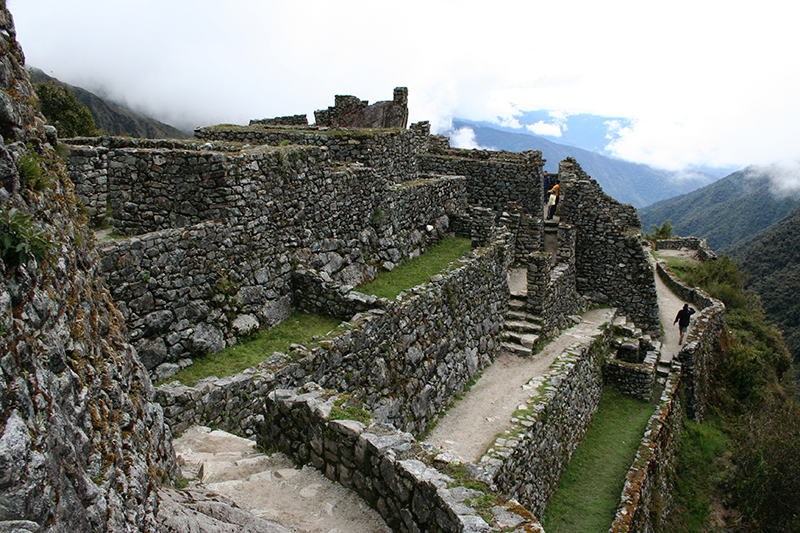 Anyway, he took his revenge on us by making us stop within sight of the night’s camp (and the toilets) at another Inca ruin, Sayaqmarka, whilst he gave us a lecture on the Inca lifestyle as clouds of little midges tried to eat us. At least 3 times he asked us ‘Any questions guys?’ as if to conclude and wait for us to begin to stand up before launching into another spiel. I am sure he was trying to do his best to entertain us but he must have seen the tortured look on all our faces and I do not think anyone had any idea what he was saying because there was an unseemly rush as soon as he finished.
Anyway, he took his revenge on us by making us stop within sight of the night’s camp (and the toilets) at another Inca ruin, Sayaqmarka, whilst he gave us a lecture on the Inca lifestyle as clouds of little midges tried to eat us. At least 3 times he asked us ‘Any questions guys?’ as if to conclude and wait for us to begin to stand up before launching into another spiel. I am sure he was trying to do his best to entertain us but he must have seen the tortured look on all our faces and I do not think anyone had any idea what he was saying because there was an unseemly rush as soon as he finished.
Happy hour the second night was a much more congenial affair as we were served ‘Macho tea’, a sweet tea laced with a local rum spirit. It went down extremely well and, thus fortified, Debbie led the group in a decision to get to Machu Picchu the next afternoon, a day early, so that we could see the sight twice, in the early evening of the next day and again in the morning of the fourth day. This involved getting permission from the National Park Rangers to bypass the last official campsite and walk down to a private campsite by the river below Machu Picchu. When permission was granted, Aldo told us that this was a very rare privilege and that we were his only group this year to be allowed to do this (and, of course, we believed him!).
Dawn the next morning was spectacular, the cloud of the previous day had rolled away to reveal the mountain landscape in all its glory. Sunlight bathed the mountain peaks, the highest being Salkantay (6264m), and the air was crystal clear and wonderfully fresh. It was good to be alive and be part of this magical place. It made you want to linger and enjoy the changing light show as the sun rose to reveal more and more of the glorious scenery.
The good news about this day was that the trail was mostly downhill from here. We started at 3,600m (11,700ft) and would finish at 2,000m (6,500ft). It seemed an excellent option before we began walking because it would give my poor lungs a bit of a rest but going downhill for the next 8 hours was not to be so easy on the knees and thigh muscles and, by the end of the day, my poor old legs were somewhat wobbly.
As the official lunch site was only 3 hours away, we went very slowly as Aldo took every opportunity to show us some of the various types of orchids (300 different ones!) that lined the route as well as the odd Inca outpost of Yunkapata (aka Intipata) and we made the lunch stop by mid morning. Here at Winaywayna there were the only warm showers to be found in the mountains; were we really going to forego this luxury? Yes, our smelly, sweaty bodies were to continue to perfume the trail. I was beginning to feel a bit self conscious about this as I had only packed 2 T shirts thinking that I would be mostly cold and had not appreciated that I would be walking in shorts and T shirt only. My shirt had now done 3 days of sweaty climbing and was capable of completing the rest of the trek by itself. But that was obviously everyone else’s problem, however, I found myself walking on my own rather a lot.
After lunch, the weather began to look threatening; the rain clouds were covering much of the peaks as it relentlessly moved in our direction. This made Aldo set off at a pace just short of a full run as he wanted us to reach The Sun Gate of Intipunku above Machu Picchu before it started to pour down. An hour later we arrived panting, sweaty and grumpy (editorial comment – Sven only!) high above the site.
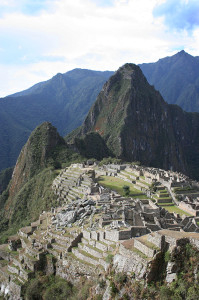 Nothing prepares you for the first sight of Machu Picchu. We have all seen the photos, we have all had the sight built up by everyone who has been there, this is the whole point of the long trek and I worried that with such a strong build up, it could only be disappointing. However, it was nothing of the sort. It is a magnificent sight, the settlement being built 2,400m up in the mountains on a site that has many different levels and many different types of building. It is miraculously well preserved, 70% of it as originally built over 500 years ago with the remainder having been carefully restored to its former glory. The Spanish Invaders never made it up here and did not get the chance to destroy it as they had done with almost every other Inca site. It must have taken years to build and the stones had to be dragged into place manually (there being no horses around before the Spanish). The most important buildings are constructed out of large stone that fit together so perfectly they do not need any kind of mortar and it is impossible to fit so much as a cigarette paper between them.
Nothing prepares you for the first sight of Machu Picchu. We have all seen the photos, we have all had the sight built up by everyone who has been there, this is the whole point of the long trek and I worried that with such a strong build up, it could only be disappointing. However, it was nothing of the sort. It is a magnificent sight, the settlement being built 2,400m up in the mountains on a site that has many different levels and many different types of building. It is miraculously well preserved, 70% of it as originally built over 500 years ago with the remainder having been carefully restored to its former glory. The Spanish Invaders never made it up here and did not get the chance to destroy it as they had done with almost every other Inca site. It must have taken years to build and the stones had to be dragged into place manually (there being no horses around before the Spanish). The most important buildings are constructed out of large stone that fit together so perfectly they do not need any kind of mortar and it is impossible to fit so much as a cigarette paper between them.
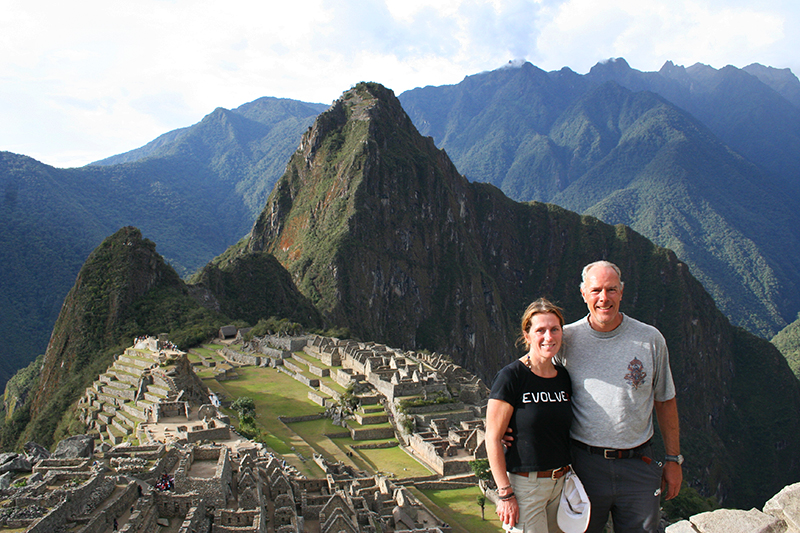 That late afternoon was mostly for photographs of the group at the site, and enjoying just being there. Tomorrow, Aldo is going to give us his official tour and he does not want to give any sneak previews before the big event. Eventually, we are persuaded to walk down to the campsite, 400m in height below the settlement and a final leg crunching drop of the day. It takes almost an hour and the bad news is that we have to come back up again tomorrow morning.
That late afternoon was mostly for photographs of the group at the site, and enjoying just being there. Tomorrow, Aldo is going to give us his official tour and he does not want to give any sneak previews before the big event. Eventually, we are persuaded to walk down to the campsite, 400m in height below the settlement and a final leg crunching drop of the day. It takes almost an hour and the bad news is that we have to come back up again tomorrow morning.
The good news was that the riverside camp was warm. Instead of going to bed covered in clothes we would now be sleeping in nothing at all. The change in temperature was dramatic and welcome as was the fact that the nearest town was only 15 minutes walk away – so the porters were dispatched with cash and a large order for beer. The warmer temperature inclined many of the group to take a shower despite there being no hot water but the girls had not factored in the creepy crawlies that survive in the warmer climate and there was much shouting and squealing as they shared their ablutions with local spiders of the large and furry variety (apparently). Debbie insisted on having 2 bowls of hot water bought to the tent to wash in private.
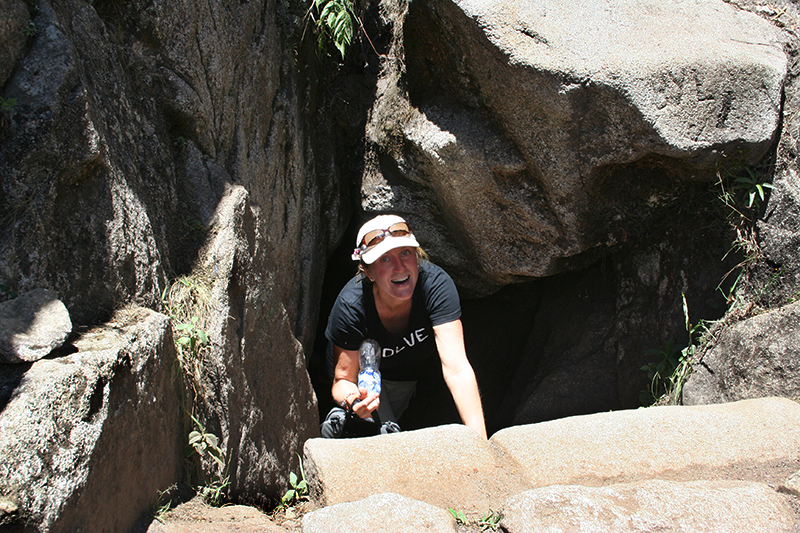 The last morning we had to be out of our pits at 4.00am. We wanted to get to the gates of Machu Picchu before 5.30am so as to be one of the 400 people that would be allowed to climb Huayna Picchu that day (there are only 400 people allowed to climb this mountain that overlooks Machu Picchu each day and it is first come first served). We left camp as a group at 4.45 with yours truly being asked to set the pace to the top. Boy, it was a slog. The steps upward are continuous and unrelenting and all the time I was focused on steadily overtaking anyone ahead of us so as to reduce the numbers in front of us at the eventual queue at the gates of the city. By the time we reached the top I had soaked my last clean T shirt in sweat but the rest of the group, of whom I had only lost 2, all looked extremely fresh. How could that be? Old age must have finally caught up with me. It was still dark and we were in cloud so we congratulated ourselves for arriving the previous day, for our first sight of the city, because there was no way that the city could have been seen from high up at the Sun Gate this morning.
The last morning we had to be out of our pits at 4.00am. We wanted to get to the gates of Machu Picchu before 5.30am so as to be one of the 400 people that would be allowed to climb Huayna Picchu that day (there are only 400 people allowed to climb this mountain that overlooks Machu Picchu each day and it is first come first served). We left camp as a group at 4.45 with yours truly being asked to set the pace to the top. Boy, it was a slog. The steps upward are continuous and unrelenting and all the time I was focused on steadily overtaking anyone ahead of us so as to reduce the numbers in front of us at the eventual queue at the gates of the city. By the time we reached the top I had soaked my last clean T shirt in sweat but the rest of the group, of whom I had only lost 2, all looked extremely fresh. How could that be? Old age must have finally caught up with me. It was still dark and we were in cloud so we congratulated ourselves for arriving the previous day, for our first sight of the city, because there was no way that the city could have been seen from high up at the Sun Gate this morning.
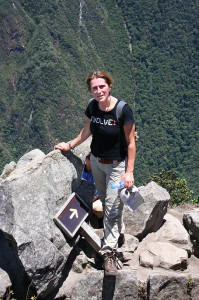 We got our Huayna Picchu tickets and by 6.00am, when the site opened, there were hundreds of people queuing behind us as a stream of visitors poured out of the first buses of the day – those that were too gutless to walk up. By 7.30 the cloud had lifted to bathe us in warm sunshine and reveal the site in its full glory. Aldo launched into his tour that took 2 hours and covered all the most interesting aspects of this unique city.
We got our Huayna Picchu tickets and by 6.00am, when the site opened, there were hundreds of people queuing behind us as a stream of visitors poured out of the first buses of the day – those that were too gutless to walk up. By 7.30 the cloud had lifted to bathe us in warm sunshine and reveal the site in its full glory. Aldo launched into his tour that took 2 hours and covered all the most interesting aspects of this unique city.
The King’s House was complete, except for the roof, and it was possible to see where he slept, ate and went to the bathroom. Sensibly, no women not even the Queen was allowed to share his space (except by special invitation) so I guess he used the time to entertain one of his (400) concubines. Apparently, he only visited Machu Picchu once a year for the winter solstice so his apartments did not get hard use.
There are numerous different temples, some for the winter solstice, some for the summer solstice, some to worship one or more of the mountains and some for observing the stars (via a pool of water through a window). There are many places for sacrifice both human and animal. The humans were chosen from children up to the age of fifteen because they were still innocent and they were chosen from the lower classes (obviously) being persuaded that when they entered heaven they would become enobled and live with the Gods.
The climb up Huayna Picchu is deliberately restricted because it is narrow and very steep. We started our climb up which was even steeper than we imagined. A lot of the steps go straight up in our faces and we had our hands on them as we crawled upwards. Coming down was even more hairy and it is a miracle that they are not accidents every day especially when it has rained. However the reward is at the top, for a superlative view of the whole site, there is the classic aerial view of Machu Picchu and it is possible to spend hours arguing about how exactly the settlement has been shaped like a Condor – if you can find the head, then where is the body and the wings? I suspect this is just another ruse by the guides to confuse stupid tourists.
You will be disappointed to hear that we took the bus back down to the town of Aguas Calientes for lunch. But by this time no one fancied another slog down the mountain for over an hour when there was a perfectly good bus available. This was the official end of the trek and we celebrated with a visit to the hot springs where our tired and smelly bodies were bathed in beautifully hot water direct from the centre of the Earth.

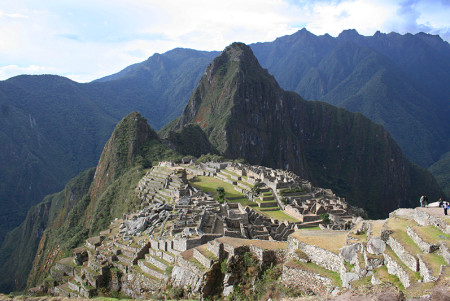
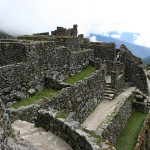
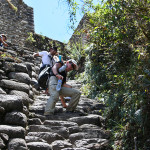
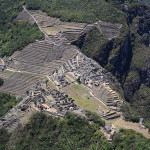
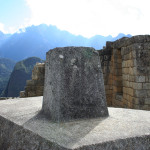
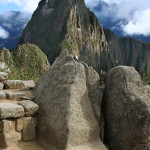
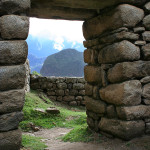
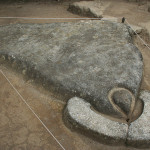
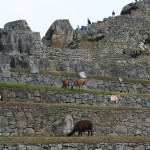
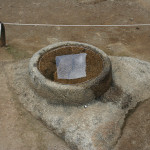
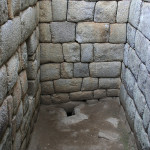
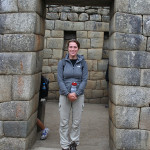
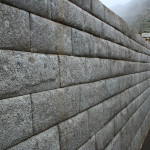
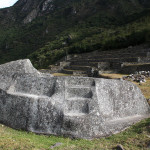
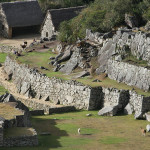
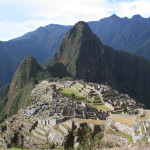
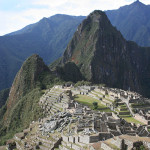
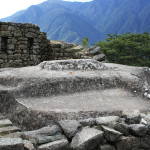
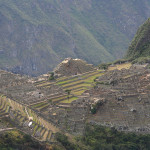
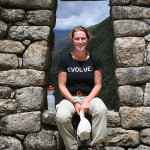
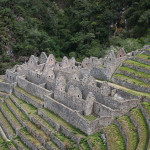
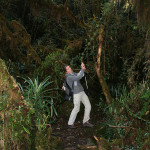
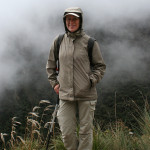
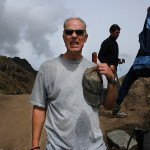
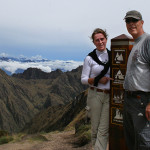
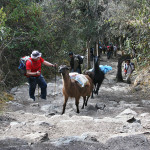
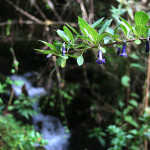
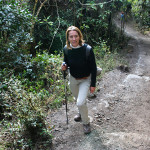
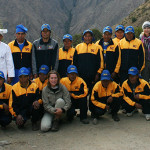
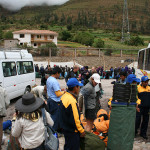
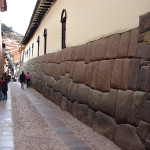
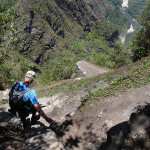
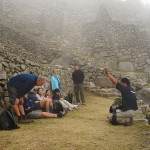
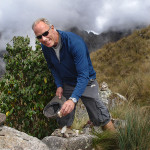
No comments yet.